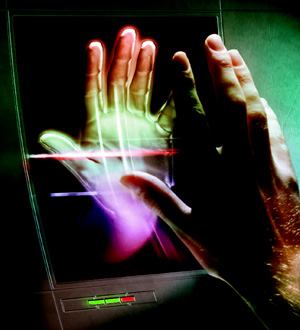Many developers of gated communities went through unforeseen growing pains with widely touted access gates. Many communities had to add cameras and other technologies to monitor gates and keep them functional. Developers learned the hard way that piling tech on tech not only complicates the security scheme but also adds unexpected expenses at a time when most companies are trying to keep costs down.
TOO MUCH INFORMATION? Regardless of the hype surrounding biometrics, some property managers are reluctant to put residents through another layer of security. As with other technology initiatives, “it might not be viewed favorably,” says McDonald.
Additionally, companies must consider the effort behind developing a database of thumbprints or retina scans of all residents. A biometrics-based security system can’t work unless residents agree to be scanned, and some invariably would consider it an invasion of privacy. So what could be a selling point—ultra-strong security—quickly could become a turn-off to prospective tenants. “Until we have a database and can transfer your biometrics data to our security system, it is still going to be too cumbersome,” says David Cardwell, vice president of Capital Markets and Technology at the National Multi Housing Council, Washington, D.C. He notes that “65 [percent] to 75 percent of the population doesn’t have fingerprints on file.”
When biometrics are added to Social Security and credit card information already on file, the privacy protection component gets even more complicated. “It’s an extra layer of burden on an owner to protect it,” says Acker.
Still, biometrics can be seen on the far horizon, making its way toward multifamily communities as costs come down and relevant applications crop up. Age-old property management problems may pave the way for biometrics to gain a stronghold in the multifamily arena. Consider perennially misplaced keys: Because keys can cost as much as $50 to replace, and locks $100 or more, plus the time and labor involved, property managers are always looking for new ways to manage locks and key systems.
Those signature swirls in our fingerprints—not to mention our matchless eyes—really could be the future of security in multifamily and beyond.
The “Biometrics Market and Industry Report 2007-2012,” recently released by the New York-based International Biometric Group, identifies fingerprints and iris recognition as two fast-growing segments, with significant growth predicted beyond the Automated Fingerprint Identification System widely used in law enforcement. “Fingerprint is expected to gain 38.1 percent of the non-AFIS biometrics market in 2007, followed by face recognition at 19 percent and iris recognition at 7.7 percent,” the report notes. “Annual iris recognition revenues are projected to approach $400 million by 2010.”
For now, the coolest of high-tech biometrics remains in the hands of Hollywood directors and in the imaginations of 12-year-old boys. But the biometric industry isn’t far behind, promising advances that are far more than skin-deep. Consider this prediction from the International Biometric Group: More than 10 percent of the industry market will eventually be given over to vein recognition.
Teri Robinson is a freelance writer in New York.
ACTION ITEMS HOW TO GO BIOMETRIC
- Weigh security risk versus cost. This is especially important when considering biometrics, whose upfront costs can strain the budget.
- Consider your residents. Some types of residents need, or desire, more protection than others.
- Calculate your key costs. How much does your company spend on replacing keys and locks? To what extent could biometrics-based access control reduce those costs?
- Determine your need for a database. What kind of effort would it take to build a database of retina or fingerprint scans? How invasive would that be to existing residents? Would biometrics-based security be a strong selling point for incoming residents?
- Protect people’s privacy. Set a policy from the start for securing sensitive data and handling requests from sources such as federal and state government officials, who have wide latitude under the Patriot Act.
